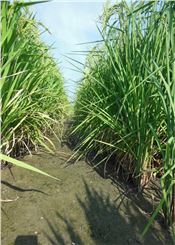|
Rice Growers Reduce Water, Maintain Yields

Alternate wetting and drying is a research-proven rice management technique that
cuts water use by up to one-third while maintaining yields. This rice was growing in a
dry paddy in Stoneville, Mississippi, on Aug. 1, 2015.
Photo by MSU Extension Service/Lee Atwill
STARKVILLE, MISS.
Mississippi State University researchers have a plan to drastically change the way rice farmers grow their crop while cutting water use by one-third and maintaining yields.
The MSU Extension Service is encouraging Mississippi rice growers to consider using alternate wetting and drying – or AWD – management in their rice fields.
About 20 percent of Mississippi farmers use some form of AWD today, but Jason Krutz, Extension irrigation specialist and Mississippi Agricultural and Forestry Experiment Station researcher, wants that number to increase.
Alternate wetting and drying is a research-proven rice management technique that cuts water use by up to one-third while maintaining yields. This rice was growing in a dry paddy in Stoneville, Mississippi, on Aug. 1, 2015. (Photo by MSU Extension Service/Lee Atwill)
“We intentionally allow the rice field to dry down after the initial flood, which is radically different than the recommendations across the Rice Belt,” Krutz said. “We establish the flood again before harvest, so we alternate between having a wet and dry field.”
Rather than letting the rice grow in 2 to 4 inches of standing water during the majority of the growing season, Krutz said MSU recommends letting the field dry to where water is 4 inches below the soil surface before flooding it again.
“Using alternate wetting and drying, we’ve been seeing a 30 percent reduction in water use and no change in yield,” Krutz said. “The economic advantage is our AWD fields are coming in about $50 ahead from water savings.”
Lee Atwill, an MSU agronomy graduate student, said the idea that rice cannot be grown without a continuous flood has been debunked.
“We’re starting to see that we can grow rice without a continuous flood, and the benefits may outweigh the negatives,” Atwill said. “AWD won’t necessarily work in every situation on every field, but for the growers who have the capacity to do it, it’s definitely a money saver and time saver.”
With the 2016 harvest, MSU completed three years of data collection on AWD rice. The 2015 and 2016 seasons offered ideal, opposite weather conditions under which to test the process.
“2015 was a very dry year. After we got the crop in and got it up, it was pretty dry for a substantial amount of time,” Atwill said. “We were able to see how far we could dry it and it still look good. Based on that data, we’re comfortable allowing the flood to subside to 4 inches below the soil surface.”
2016 offered very different growing conditions. Once the crop was brought to the flood stage, there was significant rain almost every week during the time rice fields are typically flooded.
“Our water savings are more substantial in a year with a lot of rainfall because by allowing the fields to go dry to 4 inches deep, we’re able to capture that rainfall when it happens,” he said. “In a continuous flood environment, we lose a lot of water to the tail ditch because it spills over since our paddies are already full.”
In an alternate wetting and drying field, rice is planted and nitrogen applied preflood. The initial flood is then established and maintained for 21 days to allow the rice to take up the nitrogen. Fields are allowed to dry to 4 inches deep for the next four to six weeks until the flood is brought back and maintained for the two-week period when rice is flowering, or heading.
Krutz said the water savings is not just an economic benefit. Mississippi is the only state in the Midsouth that regulates water use. By law, growers are permitted to use 36 acre-inches of water in rice.
“We use an average of 36 acre-inches of water to grow rice in Mississippi,” Krutz said. “That means 50 percent of the time, we’re using more than what we’re permitted to use. That’s why it’s critical that we have a strategy that maintains and improves yield while reducing water use. AWD is a technique that does that.” ∆
|
|